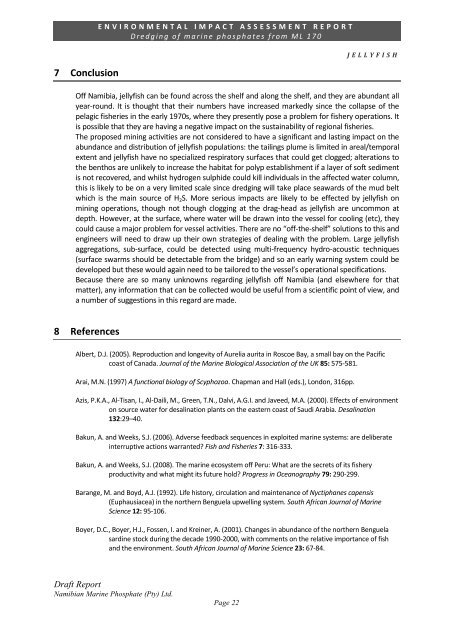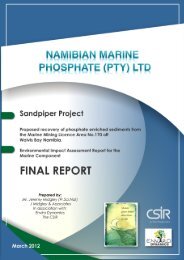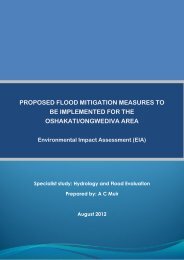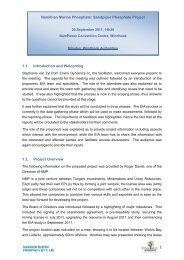Appendix 1d - Jellyfish Study.pdf - Enviro Dynamics Namibia
Appendix 1d - Jellyfish Study.pdf - Enviro Dynamics Namibia
Appendix 1d - Jellyfish Study.pdf - Enviro Dynamics Namibia
You also want an ePaper? Increase the reach of your titles
YUMPU automatically turns print PDFs into web optimized ePapers that Google loves.
7 ConclusionE N V I R O N M E N T A L I M P A C T A S S E S S M E N T R E P O R TD r e d g i n g o f m a r i n e p h o s p h a t e s f r o m M L 1 7 0J E L L Y F I S HOff <strong>Namibia</strong>, jellyfish can be found across the shelf and along the shelf, and they are abundant allyear-round. It is thought that their numbers have increased markedly since the collapse of thepelagic fisheries in the early 1970s, where they presently pose a problem for fishery operations. Itis possible that they are having a negative impact on the sustainability of regional fisheries.The proposed mining activities are not considered to have a significant and lasting impact on theabundance and distribution of jellyfish populations: the tailings plume is limited in areal/temporalextent and jellyfish have no specialized respiratory surfaces that could get clogged; alterations tothe benthos are unlikely to increase the habitat for polyp establishment if a layer of soft sedimentis not recovered, and whilst hydrogen sulphide could kill individuals in the affected water column,this is likely to be on a very limited scale since dredging will take place seawards of the mud beltwhich is the main source of H 2 S. More serious impacts are likely to be effected by jellyfish onmining operations, though not though clogging at the drag-head as jellyfish are uncommon atdepth. However, at the surface, where water will be drawn into the vessel for cooling (etc), theycould cause a major problem for vessel activities. There are no “off-the-shelf” solutions to this andengineers will need to draw up their own strategies of dealing with the problem. Large jellyfishaggregations, sub-surface, could be detected using multi-frequency hydro-acoustic techniques(surface swarms should be detectable from the bridge) and so an early warning system could bedeveloped but these would again need to be tailored to the vessel’s operational specifications.Because there are so many unknowns regarding jellyfish off <strong>Namibia</strong> (and elsewhere for thatmatter), any information that can be collected would be useful from a scientific point of view, anda number of suggestions in this regard are made.8 ReferencesAlbert, D.J. (2005). Reproduction and longevity of Aurelia aurita in Roscoe Bay, a small bay on the Pacificcoast of Canada. Journal of the Marine Biological Association of the UK 85: 575-581.Arai, M.N. (1997) A functional biology of Scyphozoa. Chapman and Hall (eds.), London, 316pp.Azis, P.K.A., Al-Tisan, I., Al-Daili, M., Green, T.N., Dalvi, A.G.I. and Javeed, M.A. (2000). Effects of environmenton source water for desalination plants on the eastern coast of Saudi Arabia. Desalination132:29–40.Bakun, A. and Weeks, S.J. (2006). Adverse feedback sequences in exploited marine systems: are deliberateinterruptive actions warranted? Fish and Fisheries 7: 316-333.Bakun, A. and Weeks, S.J. (2008). The marine ecosystem off Peru: What are the secrets of its fisheryproductivity and what might its future hold? Progress in Oceanography 79: 290-299.Barange, M. and Boyd, A.J. (1992). Life history, circulation and maintenance of Nyctiphanes capensis(Euphausiacea) in the northern Benguela upwelling system. South African Journal of MarineScience 12: 95-106.Boyer, D.C., Boyer, H.J., Fossen, I. and Kreiner, A. (2001). Changes in abundance of the northern Benguelasardine stock during the decade 1990-2000, with comments on the relative importance of fishand the environment. South African Journal of Marine Science 23: 67-84.Draft Report<strong>Namibia</strong>n Marine Phosphate (Pty) Ltd.Page 22
















